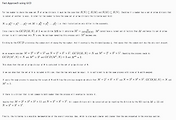Problem
A non-empty array A consisting of N numbers is given. The array is sorted in non-decreasing order. The absolute distinct count of this array is the number of distinct absolute values among the elements of the array.
For example, consider array A such that:
A[0] = -5 A[1] = -3 A[2] = -1 A[3] = 0 A[4] = 3 A[5] = 6
The absolute distinct count of this array is 5, because there are 5 distinct absolute values among the elements of this array, namely 0, 1, 3, 5 and 6.
Write a function:
int solution(vector<int> &A);
that, given a non-empty array A consisting of N numbers, returns absolute distinct count of array A.
For example, given array A such that:
A[0] = -5 A[1] = -3 A[2] = -1 A[3] = 0 A[4] = 3 A[5] = 6
the function should return 5, as explained above.
Write an efficient algorithm for the following assumptions:
- N is an integer within the range [1..100,000];
- each element of array A is an integer within the range [−2,147,483,648..2,147,483,647];
- array A is sorted in non-decreasing order.
Copyright 2009–2021 by Codility Limited. All Rights Reserved. Unauthorized copying, publication or disclosure prohibited.
How to solve
- 정보
정수로 이루어진 배열 A가 주어짐
- 구해야 하는것?
배열 A의 distict absolute value의 갯수 구해라!
- 예시
A[0] = -5
A[1] = -3
A[2] = -1
A[3] = 0
A[4] = 3
A[5] = 6
A가 위와 같이 주어졌을 때, 각 원소에 절대값을 한 수들 중 distinct value의 갯수를 return!
즉, 0, 1, 3, 5, 6 => 5개 5를 return 한다.
첫 번째 시도!
Solution1(c++)
1. 각 원소에 절대값을 씌운 값 abs_val 을 구한다.
2. absDistinct 벡터를 만들어, 벡터에 abs_val이 있는지 체크한 후 abs_val 을 넣는다.
// you can use includes, for example:
#include <bits/stdc++.h>
// you can write to stdout for debugging purposes, e.g.
// cout << "this is a debug message" << endl;
vector<int> absDistinct;
int solution(vector<int> &A) {
// write your code in C++14 (g++ 6.2.0)
int len = A.size();
for(int i=0; i<len; i++){
int abs_val= abs(A[i]);
if(find(absDistinct.begin(), absDistinct.end(), abs_val) == absDistinct.end()){
absDistinct.push_back(abs_val);
}
}
int res = absDistinct.size();
return res;
}Test Result1
퍼포먼스가 ㅠㅠ
app.codility.com/demo/results/training7EH27C-93D/


두 번째 시도!
Solution2(c++)
key값의 중복을 허용하지 않는 set container를 이용!!
set container?
- associative container중 하나
- 노드 기반 컨테이너로 균형 이진트리로 구현됨
- 중복이 허용되지 않는 key로 이루어진 컨테이너
- 원소(key)가 삽입되면 원소는 자동으로 정렬됨
// you can use includes, for example:
#include <bits/stdc++.h>
// you can write to stdout for debugging purposes, e.g.
// cout << "this is a debug message" << endl;
set<int> absDistinct;
int solution(vector<int> &A) {
// write your code in C++14 (g++ 6.2.0)
int len = A.size();
for(int i=0; i<len; i++){
int abs_val= abs(A[i]);
absDistinct.insert(abs_val);
}
int res = absDistinct.size();
return res;
}Test Result2
app.codility.com/demo/results/trainingH724PU-35M/
Test results - Codility
A non-empty array A consisting of N numbers is given. The array is sorted in non-decreasing order. The absolute distinct count of this array is the number of distinct absolute values among the elements of the array. For example, consider array A such that:
app.codility.com



'SW > 알고리즘 문제풀이' 카테고리의 다른 글
| [leetcode] Reverse Integer (0) | 2021.03.04 |
|---|---|
| [Codility] Lesson16 - Greedy algorithms: TieRopes (0) | 2021.02.25 |
| [Codility] Lesson16 - Greedy algorithms: Max Nonoverlapping Segments (1) | 2021.02.10 |
| [Codility] Lesson12 - Euclidean algorithm: Common Prime Divisors (0) | 2021.02.09 |
| [Codility] Lesson12 - euclidean algorithm: Chocolates By Numbers (1) | 2021.02.08 |




댓글